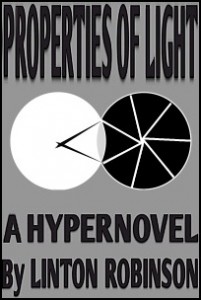 Today we have a sneak peek from the new hypernovel by Lin Robinson: Properties of Light.
Today we have a sneak peek from the new hypernovel by Lin Robinson: Properties of Light.
This is not your ordinary kind of book. A prominent photographer quits, starts selling his pictures on the street. And for every picture, there is a story–or in this case a chapter. Some of the images relate to others, some are single visual poems; some evoke horrible cruelty or shocking sex. Many of them hang on abstruse photo-technique, optical tricks, chemical or photic phenomena: the many properties of light.
This is a true hypernovel, 100 chapters connected by clicking links, not narrative sequence. It waited 20 years for a medium that lets it work — a Kindle eBook.
Properties of Light is available from Amazon and Amazon UK.
Here is an excerpt from Properties of Light…
MOON MOTH
It was utterly white against the blue water of the pool. I stepped to the edge and framed its white flutter against the deep, featureless blue of three meters of water reflecting summer sky. I watched the shadows of ripples radiating from the moth’s shadow on the bottom of the pool, crisp concentric rings pulsing across the bottom, then ascending the sides as though escaping into the air. The surface was flat except for the moth’s struggles. I shot twice–then the moth went still. This is the first of three shots of the empty circle spreading out in the middle of those rings. I lowered the camera, watched the spread of that memento mori, then scooped the moth ashore.
It started struggling again, shaking its wings dry. It fanned them then took off–immediately landing back in the pool. The ripples started again, until the whole bottom had a moving grain. It was too far out to reach conveniently. It gave another spasm and a series of ringlets sped out across the blue. When they were gone, I stared for awhile at the blank, stark white of the moth, motionless as a cloud suspended halfway up the sky.
RADIATION
You can see how this one developed. The mother cat was exploring the basement, looking for a place to have her litter. Either she fell off one of the old rotten joists, or it broke. The fall killed her, so the kittens were probably born prematurely. The furthest any made it from her body was about three feet. Notice how they radiated out in different directions. A good strategy, but they were too weak. Then the maggots leaving each little body, also fanning out, tracing their tiny trails through the dust. Finally everything dead, the dust scratched into little flowers of diverging trails. I saw the shot through an old broken cellar window, and had to lean in precariously to do it right. It’s a beautiful thing to me, an unfolding of natural precision; the bursting forth of life frozen and preserved.
LONG SHOT
With the 50mm lens, the moon is a brass dime behind the Space Needle. At 135mm, it’s almost as big as the main deck of the Needle. At 400mm, it’s starting to look like a postcard. At 800mm, it looms over the needle, big and buttery. On this 1600mm shot you see the craters, the delicate colors of magnification. The Space Needle embroiders it delicately. All a matter of perspective. With a mile-long lens I could lose the needle in a bronze flood of moon. With a long enough lens and a place to stand, I could lose the earth in grain pattern.
They claim there’s a lens that looks so deep into space that it reveals the first instant of time, when the universe itself was a bright gold penny. It’s all perspective. The longer you look, the bigger things get. Look long enough and you’re lost.
